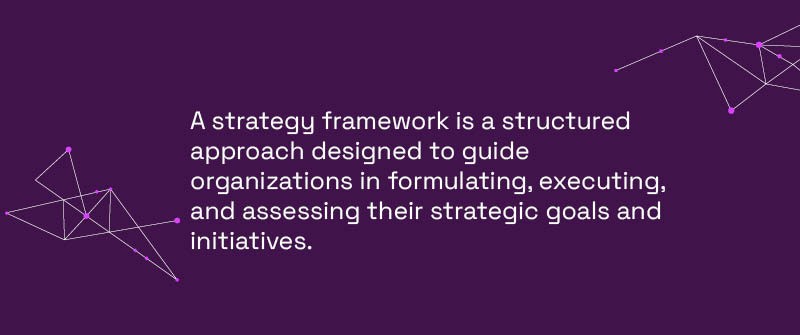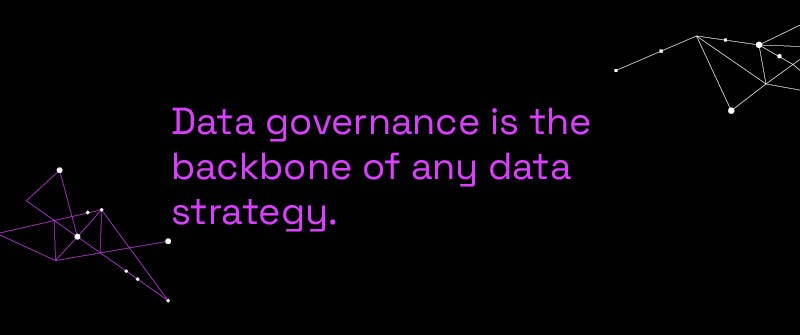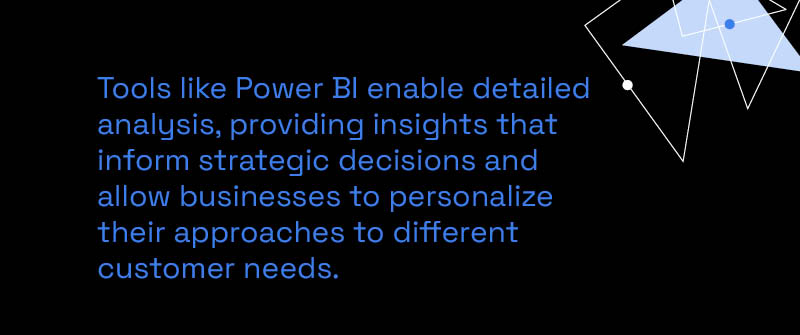
What Is a Strategy Framework?
A strategy framework is a structured approach designed to guide organizations in formulating, executing, and assessing their strategic goals and initiatives. This framework serves as a blueprint, helping businesses align their resources and actions with overarching objectives. It provides clarity and direction, ensuring that every team member understands their role in achieving strategic targets by integrating a comprehensive data strategy that aligns with business objectives and maximizes the value of data assets.
The purpose of a strategy framework is multifaceted. It helps in the systematic identification of strategic priorities, allocating resources efficiently, and managing risks effectively. By offering a consistent and cohesive structure, it supports business leaders in making informed decisions and in communicating their strategy both internally and externally. Incorporating Business Intelligence Consulting Services into this process can further enhance decision-making by providing data-driven insights and tailored solutions. This framework is critical for maintaining focus and coherence across all levels of an organization.
While a strategy framework provides the overarching structure and guidelines, a strategy plan is more specific and detailed. A strategy plan outlines the actual initiatives, timelines, and metrics for success. In other words, the framework offers the ‘what’ and ‘why,’ while the plan provides the ‘how’ and ‘when.’ Understanding this distinction is crucial for business leaders to effectively implement a strategy that drives growth and innovation.

What Is The Meaning Of Data Framework?
A data framework is fundamentally a structured arrangement designed to manage and utilize data effectively within an organization. As businesses collect and analyze increasingly vast amounts of information, having an efficient data framework is pivotal. It serves as a blueprint that guides how data is gathered, processed, stored, and leveraged to achieve strategic business objectives. This structured approach ensures that data management not only supports but also enhances organizational performance and decision-making.
Components of a Data Framework
A robust data framework typically comprises several key components. First is the data governance model, which establishes policies and procedures for data use, ensuring consistency and compliance across various departments. Another core component is data architecture, detailing the structural design of data systems and processes. It defines how data flows within the organization, the storage solutions in place, and the infrastructure supporting data operations.
Role of Data Frameworks in Business
Incorporating a data framework into your business strategy offers numerous benefits. It brings order to the complexity of data management, fostering an environment where data can be accessed and utilized efficiently. Moreover, frameworks facilitate interdepartmental collaboration by providing a unified approach to data handling, enhancing trust, and guiding data-driven initiatives. A well-implemented data framework is also essential for aligning data-related endeavors with the company’s long-term strategic goals, ensuring that every data activity contributes to a broader objective. Additionally, having the right personnel, including data analysts, is crucial for effectively implementing technology and processes that drive business objectives.
Integration of Data Frameworks with Business Strategies
Integrating a data framework with existing business strategies is crucial for maximizing its potential. It involves tailoring the framework to support specific business objectives through the data strategy roadmap, which includes understanding the datasets available within various business units. This roadmap acts as a guide for executing the data framework, aligning data practices with business demands, and ensuring that data becomes a valuable asset rather than just an operational input. As businesses evolve, continuously refining the data framework is essential for maintaining the alignment between data capabilities and business vision.
What Are the 5 Components of Data Strategy?
Understanding the Core Components
Building a successful data strategy roadmap starts with understanding its five fundamental components. Each of these plays a vital role in effectively managing data and unlocking its potential to drive strategic decisions and operational improvements.
Raw data serves as a strategic information asset, emphasizing the need for efficient data architecture and processes to analyze and utilize this data for informed decision-making.
Data Governance Structure
Data governance is the backbone of any data strategy. It involves establishing policies and procedures to manage data responsibly within your organization. This component ensures data integrity and security by defining data ownership, setting access controls, and making sure you comply with legal and regulatory requirements. By prioritizing data governance, businesses create a foundation that supports trust in the data they manage.

Data Architecture and Infrastructure
Data architecture entails designing the structure of data systems. This includes the ways data is collected, stored, processed, and accessed throughout the organization. A robust data architecture ensures smooth data flow, enabling scalability and flexibility. It allows you to create an infrastructure that not only supports current business needs but also adapts to future demands and technological advances. Data engineers play a crucial role in this process by building and maintaining the systems that support effective data strategy implementation.
Need more information? Contact P3 about Data Strategy Consulting!
Data Management Processes
Efficient data management processes are crucial for organizing, storing, and retrieving data in a way that aligns with your strategic objectives. This component involves a thoughtful approach to managing the data lifecycle, ensuring data quality, consistency, and availability. Proper management processes powered by innovative tools, such as those provided by P3 Adaptive, can significantly enhance data utilization and integration.
Analytics and Data Democratization
Analytics comes into play when transforming data into actionable insights. Leveraging analytics and promoting data democratization empowers decision-makers across all organizational levels with access to data insights. This component is essential for creating a data-driven culture where data insights are readily available for analysis and strategic decision-making.
Compliance and Security Measures
In a data-centric business environment, compliance and security are paramount. Implementing comprehensive security measures such as encryption, network security, and regular audits protects data from unauthorized access and breaches. Ensuring compliance with data protection regulations not only safeguards your data but also reinforces your organization’s reputation and reliability.
These five components form the backbone of a comprehensive and effective data strategy. By integrating them into your strategy, you can harness the full potential of your data, turning it into a powerful tool for achieving your business goals. Embracing these principles not only improves data management practices but also lays the groundwork for innovative and strategic growth, as exemplified by world-class solutions from P3 Adaptive.
What Is a Data Strategy Example?
Illustration of a Successful Data Strategy
A compelling data strategy example can be found in the retail industry, where businesses leverage data to enhance customer satisfaction and drive sales growth. For instance, a retail company might craft a strategy that integrates data collection from various customer interactions, including online and in-store purchases, social media engagement, and feedback surveys. This approach gathers significant insights into customer preferences, purchasing habits, and market trends.
Case Study Analysis
Consider a Bar Keeper’s Friend who implemented a robust data strategy using Power BI for data analysis. The company aimed to refine its marketing strategies and optimize its product offerings. Through this data-driven approach, the company successfully identified patterns and customer segments that warranted personalized marketing tactics, leading to increased customer engagement and higher sales.
Lessons Learned from the Example
This example teaches several vital lessons about crafting a successful data strategy. Firstly, data must be collected and stored systematically, ensuring it is accessible and analyzable. Tools like Power BI enable detailed analysis, providing insights that inform strategic decisions and allow businesses to personalize their approaches to different customer needs. Secondly, securing data while ensuring compliance with privacy regulations is crucial. By adopting robust data governance practices, companies safeguard their data and maintain customer trust.
P3 Adaptive offers the expertise and tools necessary to guide businesses in developing such effective data strategies. By capitalizing on advanced technologies and insightful analytics, organizations can transform their data assets into actionable insights and foster substantial growth.

Creating an Effective Data Strategy Template
Building a data strategy template is crucial for businesses aiming to transform their data into a powerful strategic asset. Creating a data strategy is a collaborative process involving multiple roles within the organization. A well-crafted template serves as a blueprint, guiding organizations in defining clear data objectives and aligning these with broader business goals. In this section, we will explore the key elements to include in a data strategy template, the steps to develop it, and ways to ensure it aligns seamlessly with your business objectives.
Key Elements of a Data Strategy Template
To create an effective data strategy template, several critical components must be included:
- Vision and Objectives: Clearly articulate your business’s data vision and the specific objectives of your data strategy. This will ensure that efforts are cohesive and aligned with organizational goals.
- Data Governance: Outline the governance structure to manage data policies, compliance, and quality assurance. This framework should detail roles, responsibilities, and accountability mechanisms.
- Data Architecture and Infrastructure: Define the technological and structural foundations for data storage, processing, and access. This includes identifying necessary platforms and tools, such as Microsoft Fabric and Power BI.
- Analytics and Insights Generation: Specify the methodologies for data analysis and insight generation. Highlight how data will be transformed into actionable intelligence.
- Monitoring and Revision: Establish a process for monitoring the strategy’s effectiveness and revising it as needed to accommodate evolving business landscapes.
Steps to Develop a Data Strategy Template
Creating a data strategy template requires a systematic approach:
- Assessment: Begin with a comprehensive assessment of current data capabilities and infrastructure, identifying gaps and opportunities for improvement.
- Design: Develop a design phase where the structure and contents of the template are outlined. Collaborate with key stakeholders to ensure alignment with business objectives.
- Implementation: Roll out the data strategy, ensuring that all team members are engaged and understand their roles. Use tools and solutions tailored to your organization’s specific needs.
- Evaluation and Feedback: Regularly evaluate the strategy’s performance against set KPIs and gather feedback for continuous improvement.
Aligning Business Goals with Data Strategy
At the heart of any effective data strategy is a seamless alignment with business goals. P3 Adaptive excels in crafting data strategies that transform data into a true strategic asset, integrated across all areas of your organization—from executive decision-making to customer engagement. Our approach combines cutting-edge technology with hands-on consulting expertise, ensuring that your data strategy not only meets today’s demands but also adapts to future shifts in the business landscape. Appointing a Chief Data Officer (CDO) can further align business goals with data strategy by providing a structured framework for effectively utilizing data across the enterprise.
With P3 Adaptive, your organization gains a partner dedicated to making data a driver of measurable value and competitive advantage. Our team’s deep expertise helps you navigate complex data challenges with confidence, leveraging data to fuel growth and enhance agility. Discover how P3 Adaptive’s data strategy consulting can turn your biggest data challenges into a roadmap for success, empowering your leadership and elevating your organization’s strategic impact. Contact the P3 Adaptive team today!
Get in touch with a P3 team member